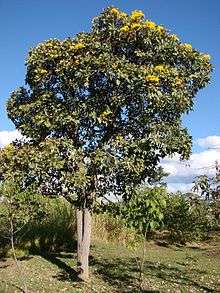Tabebuia aurea
Tabebuia aurea is a species of Tabebuia native to South America in Suriname, Brazil, eastern Bolivia, Peru, Paraguay, and northern Argentina. The common English name Caribbean trumpet tree is misleading, as it is not native to the Caribbean. It is also known as the silver trumpet tree,[2] and tree of gold.[3]
| Tabebuia aurea | |
|---|---|
 | |
| Scientific classification | |
| Kingdom: | Plantae |
| Clade: | Tracheophytes |
| Clade: | Angiosperms |
| Clade: | Eudicots |
| Clade: | Asterids |
| Order: | Lamiales |
| Family: | Bignoniaceae |
| Genus: | Tabebuia |
| Species: | T. aurea |
| Binomial name | |
| Tabebuia aurea | |
| Synonyms[1] | |
| |
Description
It is a small dry season-deciduous tree growing to 8 m tall. The leaves are palmately compound, with five or seven leaflets, each leaflet 6–18 cm long, green with silvery scales both above and below.
The flowers are bright yellow, up to 6.5 cm diameter, produced several together in a loose panicle. The fruit is a slender 10 cm long capsule.[3][4]
- Cultivation
It is a popular ornamental tree in subtropical and tropical regions, grown for its spectacular flower display on leafless shoots at the end of the dry season.[4]
Ecology
This species presence in riparian areas of the Caatinga of northeastern Brazil is a crucial resource for Spix's macaw (Cyanopsitta spixii), which is extinct in the wild with fewer than 100 birds remaining in captivity. Any future reintroduction would have to provide sufficient T. aurea for nesting and other purposes - while the tree is not considered threatened on a global scale, locally it has declined due to unsustainable use for timber and some other factors.
References
- "The Plant List: A Working List of All Plant Species". Retrieved June 3, 2014.
- Kepler, Angela Kay (1990). Trees of Hawai'i, p. 7. Honolulu: University of Hawaii Press. ISBN 9780824813291.
- "Tabebuia aurea". Germplasm Resources Information Network (GRIN). Agricultural Research Service (ARS), United States Department of Agriculture (USDA). Retrieved January 1, 2018.
- Huxley, A., ed. (1992). New RHS Dictionary of Gardening. Macmillan ISBN 0-333-47494-5.
Further reading
- Bueno, M.L.; Damasceno-Junior, G.A.; Pott, A. (May 2014). "Structure of arboreal and herbaceous strata in a neotropical seasonally flooded monodominant savanna of Tabebuia aurea". Brazilian Journal of Biology. 74 (2): 325–337. doi:10.1590/1519-6984.16612.
- Reis, FP; Senna Bonfa, IM; Cavalcante, RB; et al. (December 2014). "Tabebuia aurea decreases inflammatory, myotoxic and hemorrhagic activities induced by the venom of Bothrops neuwiedi". Journal of Ethnopharmacology. 158 (Pt A): 352–7. doi:10.1016/j.jep.2014.10.045. PMID 25446588.
 flowers & leaves
flowers & leaves_fruit_W_IMG_7052.jpg) fruits
fruits_with_a_dried_fruit_W_IMG_8180.jpg) dried fruit
dried fruit_trunk_in_Hyderabad%2C_AP_W_IMG_6553.jpg) trunk
trunk
| Wikimedia Commons has media related to Tabebuia aurea. |
| Wikispecies has information related to Tabebuia aurea |
